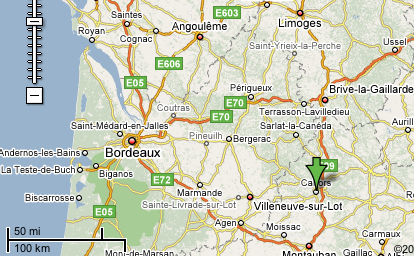Wine from Cahors series: Clos de Gamot 2000
Posted on April 27th, 2008
Saved in Red wine, Sour Grapes recommends, Wine
A bit of background to Cahors
Cahors is more or less 180km due east of Bordeaux in an area called Lot, in the greater Quercy region. Some of the vineyards date back to Roman times. More recently, in the late 1800′s, most of the vineyards were wiped out by Phylloxera.
Cahors has, for hundreds of years, been trying to eek out a living under the shadow of Bordeaux. However, this is slowing changing, with a growing number of Cahors available on the shelves of most Irish wine shops.
However, the new threat to Cahors could be said to be Argentinian Malbec, which is getting better and better. Poor Cahors will never have it easy.

The main grape of Cahors is Malbec (also referred to as Auxerrois amongst other local names), which under AOC Cahors regulations, must make up at least 70%. The rest is usually made up of Merlot or Tannat.
What does Cahors wine taste like?
Some comments on Cahors in a thread on the letstalkwine.com forum:
Cahors tends to be very tannic and lasts many years. I always drink Cahors with food as it is such a big wine.
A full bodied who can be waited a few years at least. A good decanting or an early opening is recommended.
So, with the wine facts out of the way, the first in this Cahors series is the Clos de Gamot.
Clos de Gamot 2000, Jean Jouffreau 2000, 12.5% ABV (€18)
I’d read that it’s worth decanting and airing a big Cahors wine for a couple of hours before drinking, so that’s what I did.
At over seven years old, I expected all the characteristic strong tannins that I’d read about to have chilled out just a little a bit. However, this simply wasn’t the case.
If ever you want to understand what a tannic wine is all about, then this is the wine that would teach you. I’d describe it as clinging to your gums with a really dry sensation as if all the moisture is suddenly sucked out of your mouth.
However, all this tannin is not necessarily a bad thing – it allows the wine to age really well, 20-30 years potentially, and also makes for an excellent partner to strong red meat – I had it with a venison casserole I cooked at home.
I tasted without food at first and it was full on, almost too much so. But when open for a while and with food, it was a great wine. Proteins in red meat tend to break down tannins and in this case, it’s true.
If you’ve ever heard the phrase “a great food wine”, this is a good example of it. This one is a full bodied, concentrated, acidic and tannic monster which needs a good strongly flavoured meat dish. That, or you could just keep it 20 years or so and see how it goes on its own.
- Looks: deep dark intense ruby
- Smells: dark fruit and spices
- Tastes: Plum, pepper, cloves, liquorice and really really strong tannins – too much to drink on its own at least for the next 20 years!
- Availability: Picked this up in Wolfe’s on Capel Street, Dublin for about €18.
Previously on sourgrapes.ie: Chatons du Cèdre 2000
One of the first posts I wrote in 2007 was on a Cahors, (Chatons du Cèdre), but from memory it bears very little resemblance to the above, it was far softer (no doubt due to the 20% merlot, which is often used to soften the likes of Cabernet Sauvignon in Aussie and Bordeaux red wines).
Other sources for information on wine from Cahors:
- Gary Vaynerchuk does Cahors on Wine Library TV
- www.french-malbec.com/
- https://www.vindecahors.fr/

[...] and we might read from time to time some unfortunate comments such as those published in the blog sourgrapes.com: "[...]the new threat to Cahors could be said to be Argentinian Malbec, which is getting [...]
[...] Triguedina, another wine from Cahors, and one of the better [...]
[...] my first post on wine from Cahors, I wrote “the new threat to Cahors could be said to be Argentinian Malbec, which is getting [...]